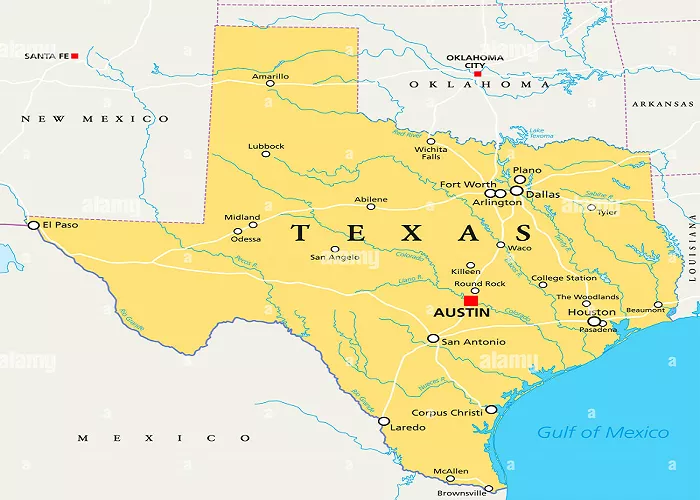Austin, the capital of Texas, is a vibrant city known for its live music, booming tech industry, and beautiful outdoor spaces. But where exactly is Austin located on the map? This guide explores Austin’s geographical position, cultural significance, economic influence, and ecological diversity. Whether you’re planning a visit, relocating, or just curious, this article provides a comprehensive look at Austin’s place in Texas and the U.S.
Geographical Location of Austin, Texas
Austin is located in central Texas, about 80 miles (130 km) northeast of San Antonio and 160 miles (260 km) west of Houston. It sits near the Balcones Escarpment, a geological fault line separating the Texas Hill Country from the coastal plains.
Latitude & Longitude: 30.2672° N, 97.7431° W
Elevation: Approximately 489 feet (149 meters) above sea level
Nearest Major Cities:
- San Antonio (80 miles southwest)
- Houston (160 miles east)
- Dallas (195 miles north)
Austin’s Position in Texas
Austin is in Travis County and serves as the state capital. It is part of the “Texas Triangle”, a region including Houston, San Antonio, and Dallas-Fort Worth, which holds most of Texas’ population and economic activity.
Key Landmarks & Natural Features
- Colorado River: Flows through downtown Austin, forming Lady Bird Lake.
- Texas Hill Country: To the west, featuring rolling hills and natural springs.
- Balcones Canyonlands: A protected area with diverse wildlife.
Central Texas Setting
Austin is located in Central Texas, approximately 74 miles northeast of San Antonio, 146 miles northwest of Houston, and 182 miles south of Dallas. The city sits at the base of the Balcones Escarpment on the Colorado River, encompassing parts of Travis, Hays, and Williamson counties.
Topography and Natural Features
The city’s terrain varies from flat plains in the east to rolling hills in the west, part of the Texas Hill Country. Austin is home to several lakes and rivers, including Lady Bird Lake, Lake Austin, and Lake Travis, which offer recreational opportunities and scenic beauty.
Climate
Austin experiences a humid subtropical climate with hot summers and mild winters. The city averages 34.2 inches of rainfall annually, with May, October, and June being the wettest months. Severe weather, including hail and strong winds, is common in the spring.
Cultural Highlights
Music Scene
Known as the “Live Music Capital of the World,” Austin boasts a vibrant music scene with numerous venues and festivals. The city hosts the annual South by Southwest (SXSW) festival, attracting artists and audiences from around the globe.
Culinary Delights
Austin’s food scene is a fusion of Tex-Mex, barbecue, and innovative cuisine. Renowned establishments like Franklin Barbecue and Veracruz All Natural offer iconic dishes. The city’s diverse neighborhoods, such as East Austin and South Lamar, provide unique dining experiences.
Arts and Festivals
The city celebrates its artistic spirit through various events and installations. The Pecan Street Festival, held biannually, showcases local art, music, and food, drawing large crowds to Sixth Street.
Economic Landscape
Tech Industry
Austin has emerged as a significant tech hub, attracting companies and startups. The city’s economy benefits from robust job and wage growth, primarily driven by the tech sector.
Education and Research
Home to the University of Texas at Austin, the city fosters a strong educational and research environment. The university contributes to the local economy and cultural scene.
Business Growth
Austin’s business-friendly environment has led to the growth of various industries, including biotech, with companies like Colossal Biosciences achieving significant milestones.
Ecological Features
Natural Attractions
Austin offers numerous natural attractions, such as Barton Springs Pool and Mount Bonnell, providing residents and visitors with opportunities for outdoor activities and scenic views.
Parks and Green Spaces
The city’s commitment to sustainability is evident in its parks and green initiatives. Programs like PARKners focus on improving park spaces and the environment, enhancing the quality of life for residents.
Wildlife and Conservation
Austin’s diverse ecosystems support various wildlife species. Conservation efforts aim to preserve natural habitats and promote biodiversity within the urban landscape.
Conclusion
Austin, Texas, stands out as a city that harmoniously blends natural beauty, cultural richness, economic vitality, and ecological responsibility. Its central location, dynamic culture, thriving economy, and commitment to sustainability make it a unique and appealing destination for residents and visitors alike.

